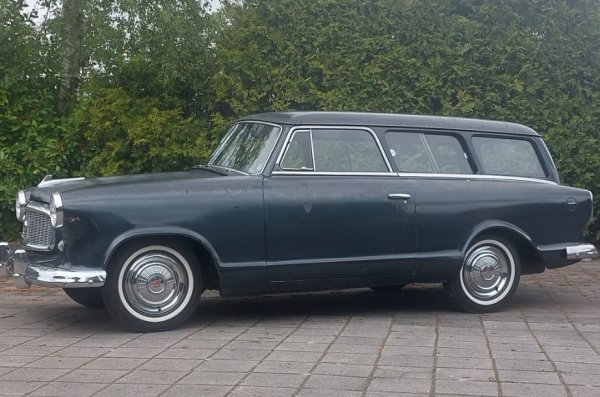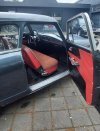Back in time: The American Wagon 1959 and the lingering influence of an icon
Cars from the '50s and '60s emanate a unique charm. Their distinct designs and raw power are vastly different from today's compact, efficient models. The chrome accents and characteristic silhouettes reflect the era's innovation and technical prowess. Among these nostalgic gems, one particularly stands out, the 1959 Rambler American Wagon.
The 1959 Rambler American Wagon was a product of its time, born during an era of rampant progress and optimism in the United States. This was the baby boom era when families were growing and the demand for larger, roomier cars increased. The station wagon, a novel vehicle concept, was a perfect solution.
Rambler, a division of American Motors Corporation (AMC), was one of the brands serving this expanding market. The American Wagon, introduced in 1958, was their response to the demand for spacious, practical vehicles. It sported a simple, sober design, a reliable 3200cc flathead engine, and a compact size, a rarity during a time when 'bigger is better' seemed to be the motto.
What set this car apart, however, was its unibody design. The concept of an integrated chassis made the body more rigid, lighter, and much more compact than traditional body-on-frame construction. This was a groundbreaking idea and a harbinger of the future of car design.
But the Rambler American Wagon wasn't just innovative, it was iconic. This was a car that embodied the zeitgeist, a symbol of post-war America's optimism and ambition. It transported families from coast to coast, a faithful companion on road trips and Sunday outings. It was the car that defined the face of American roads.
It wasn't long before the American Wagon became popular among auto enthusiasts. Despite being smaller and less luxurious than some of its contemporaries, the American Wagon had a certain charm. Perhaps it was its robust reliability, or its practical design, or maybe it was just its quintessential Americanness. Whatever it was, it worked. The American Wagon became a commercial success, helping Rambler to gain a foothold in the competitive American auto market.
As the years progressed, the American Wagon continued to evolve. New models and variants were introduced, such as the more luxurious 'Super' and the sportier 'Rebel'. But despite these changes, the essence of the American Wagon remained the same, even as the decade turned and the '60s began. Yet, the competition hadn't remained idle. The landscape of the American auto world began to shift. Larger, more powerful cars began to dominate the market, fueled by post-war America's growing prosperity. In this context, the Rambler American Wagon remained a notable choice.
What is the secret to the enduring allure of the 1959 Rambler American Wagon? Perhaps it was its firm place in American pop culture. From film and television to music, the American Wagon had acquired an iconic status that transcended its practical attributes. It was a symbol of an era, a piece of history on four wheels.
The vehicle also had another unique factor. The 1959 Rambler American Wagon was a pioneer in the use of the unibody design, a design principle that is applied in many cars today. Unibody, or monocoque, is a construction method where the car's chassis and body are integrated into a single unit, enhancing the overall strength and rigidity of the vehicle. This pioneering design made the Rambler American Wagon not only
revolutionary in its time but maintains its relevance even today.
But even the best design cannot escape the ravages of time. Rambler faced escalating costs and diminishing demand, leading to a series of financial difficulties. By the late '60s, the Rambler brand had all but vanished from the streets. American Motors Corporation, Rambler's parent company, was eventually bought out by Chrysler in 1987, and the Rambler name was effectively retired.
Despite this, the 1959 Rambler American Wagon left a lasting impression. It's more than just a car, it's a piece of American history. For many, it's a symbol of a simpler, more optimistic time. It's a reminder of the days of the open road, the freedom of travel, and the innocent joy of discovery.
It's no wonder that the 1959 Rambler American Wagon remains a cherished item among car enthusiasts and collectors today. Its simple charm, robust reliability, and undeniable nostalgia make this car a beloved collectible.
This vehicle represents a time when cars were more than just a means of transportation, but also a statement. It was an era when a car like the 1959 Rambler American Wagon could serve as a symbol of status and personal freedom.
Today, a luxury SUV or electric sports car might be seen as a status symbol, but back in the late '50s and early '60s, a car like the 1959 Rambler American Wagon could offer the same sense of prestige and individuality. Just as we now enjoy the sleek, futuristic design of the latest Tesla, people back then relished the robust, simple shapes of their reliable Rambler.
The price tag of a brand-new 1959 Rambler American Wagon was approximately $2,000 (€1850). That might sound like a bargain compared to today's prices, but adjusted for inflation, that's equivalent to about $18 000 (€16,700) in today's money. Clearly, this car was affordable, but not cheap. As with modern cars today, purchasing a new car was a significant investment.
However, it wasn't just the American Wagon that was in the spotlight. Rambler released other memorable models, such as the 1962 Rambler Wagon and the Rambler Cross Country Pininfarina. Each of these models contributed to the brand's heritage and played a role in the changing trends of car design.
The 1962 Rambler Wagon, for instance, was an evolution of the original concept, featuring a refreshed design and improved performance. The model stayed true to its roots and retained the simple, rugged character of its predecessor.
The Rambler Cross Country Pininfarina, on the other hand, was a unique experiment. It was the result of a collaboration between Rambler and the renowned Italian design firm Pininfarina. Though not as successful as hoped, it remains an interesting example of the creative ideas being explored at the time.
All of this makes the story of Rambler, and especially the 1959 Rambler American Wagon, so captivating. Despite the brand's eventual downfall, it lives on in the hearts and minds of car enthusiasts worldwide.
In summary, the 1959 Rambler American Wagon is more than just a car. It's a piece of history, an icon of an era, a symbol of an innocent, optimistic time. The 1959 Rambler American Wagon may be a product of its time, but its charm and appeal are timeless. And that, one might say, is the true magic of this remarkable car.
Has reading this article sparked your interest in Rambler models? At Continental Cars, we have a selection available for you:
- Rambler American Wagon 1959
- Rambler Cross Country Pininfarina
- Rambler Wagon 1962
We warmly invite you to view these classic models, either online or in our showroom. If you have any questions, please don't hesitate to get in touch with us.
The birth of a classic
The 1959 Rambler American Wagon was a product of its time, born during an era of rampant progress and optimism in the United States. This was the baby boom era when families were growing and the demand for larger, roomier cars increased. The station wagon, a novel vehicle concept, was a perfect solution.
Rambler, a division of American Motors Corporation (AMC), was one of the brands serving this expanding market. The American Wagon, introduced in 1958, was their response to the demand for spacious, practical vehicles. It sported a simple, sober design, a reliable 3200cc flathead engine, and a compact size, a rarity during a time when 'bigger is better' seemed to be the motto.
What set this car apart, however, was its unibody design. The concept of an integrated chassis made the body more rigid, lighter, and much more compact than traditional body-on-frame construction. This was a groundbreaking idea and a harbinger of the future of car design.
But the Rambler American Wagon wasn't just innovative, it was iconic. This was a car that embodied the zeitgeist, a symbol of post-war America's optimism and ambition. It transported families from coast to coast, a faithful companion on road trips and Sunday outings. It was the car that defined the face of American roads.
It wasn't long before the American Wagon became popular among auto enthusiasts. Despite being smaller and less luxurious than some of its contemporaries, the American Wagon had a certain charm. Perhaps it was its robust reliability, or its practical design, or maybe it was just its quintessential Americanness. Whatever it was, it worked. The American Wagon became a commercial success, helping Rambler to gain a foothold in the competitive American auto market.
The Rambler American Wagon: More Than just a car
As the years progressed, the American Wagon continued to evolve. New models and variants were introduced, such as the more luxurious 'Super' and the sportier 'Rebel'. But despite these changes, the essence of the American Wagon remained the same, even as the decade turned and the '60s began. Yet, the competition hadn't remained idle. The landscape of the American auto world began to shift. Larger, more powerful cars began to dominate the market, fueled by post-war America's growing prosperity. In this context, the Rambler American Wagon remained a notable choice.
What is the secret to the enduring allure of the 1959 Rambler American Wagon? Perhaps it was its firm place in American pop culture. From film and television to music, the American Wagon had acquired an iconic status that transcended its practical attributes. It was a symbol of an era, a piece of history on four wheels.
The vehicle also had another unique factor. The 1959 Rambler American Wagon was a pioneer in the use of the unibody design, a design principle that is applied in many cars today. Unibody, or monocoque, is a construction method where the car's chassis and body are integrated into a single unit, enhancing the overall strength and rigidity of the vehicle. This pioneering design made the Rambler American Wagon not only
revolutionary in its time but maintains its relevance even today.
But even the best design cannot escape the ravages of time. Rambler faced escalating costs and diminishing demand, leading to a series of financial difficulties. By the late '60s, the Rambler brand had all but vanished from the streets. American Motors Corporation, Rambler's parent company, was eventually bought out by Chrysler in 1987, and the Rambler name was effectively retired.
Despite this, the 1959 Rambler American Wagon left a lasting impression. It's more than just a car, it's a piece of American history. For many, it's a symbol of a simpler, more optimistic time. It's a reminder of the days of the open road, the freedom of travel, and the innocent joy of discovery.
It's no wonder that the 1959 Rambler American Wagon remains a cherished item among car enthusiasts and collectors today. Its simple charm, robust reliability, and undeniable nostalgia make this car a beloved collectible.
Status Symbols: Then and Now
This vehicle represents a time when cars were more than just a means of transportation, but also a statement. It was an era when a car like the 1959 Rambler American Wagon could serve as a symbol of status and personal freedom.
Today, a luxury SUV or electric sports car might be seen as a status symbol, but back in the late '50s and early '60s, a car like the 1959 Rambler American Wagon could offer the same sense of prestige and individuality. Just as we now enjoy the sleek, futuristic design of the latest Tesla, people back then relished the robust, simple shapes of their reliable Rambler.
The price tag of a brand-new 1959 Rambler American Wagon was approximately $2,000 (€1850). That might sound like a bargain compared to today's prices, but adjusted for inflation, that's equivalent to about $18 000 (€16,700) in today's money. Clearly, this car was affordable, but not cheap. As with modern cars today, purchasing a new car was a significant investment.
Rambler's Other Iconic Models
However, it wasn't just the American Wagon that was in the spotlight. Rambler released other memorable models, such as the 1962 Rambler Wagon and the Rambler Cross Country Pininfarina. Each of these models contributed to the brand's heritage and played a role in the changing trends of car design.
The 1962 Rambler Wagon, for instance, was an evolution of the original concept, featuring a refreshed design and improved performance. The model stayed true to its roots and retained the simple, rugged character of its predecessor.
The Rambler Cross Country Pininfarina, on the other hand, was a unique experiment. It was the result of a collaboration between Rambler and the renowned Italian design firm Pininfarina. Though not as successful as hoped, it remains an interesting example of the creative ideas being explored at the time.
All of this makes the story of Rambler, and especially the 1959 Rambler American Wagon, so captivating. Despite the brand's eventual downfall, it lives on in the hearts and minds of car enthusiasts worldwide.
In summary, the 1959 Rambler American Wagon is more than just a car. It's a piece of history, an icon of an era, a symbol of an innocent, optimistic time. The 1959 Rambler American Wagon may be a product of its time, but its charm and appeal are timeless. And that, one might say, is the true magic of this remarkable car.
Has reading this article sparked your interest in Rambler models? At Continental Cars, we have a selection available for you:
- Rambler American Wagon 1959
- Rambler Cross Country Pininfarina
- Rambler Wagon 1962
We warmly invite you to view these classic models, either online or in our showroom. If you have any questions, please don't hesitate to get in touch with us.
 Nederlands
Nederlands English
English























